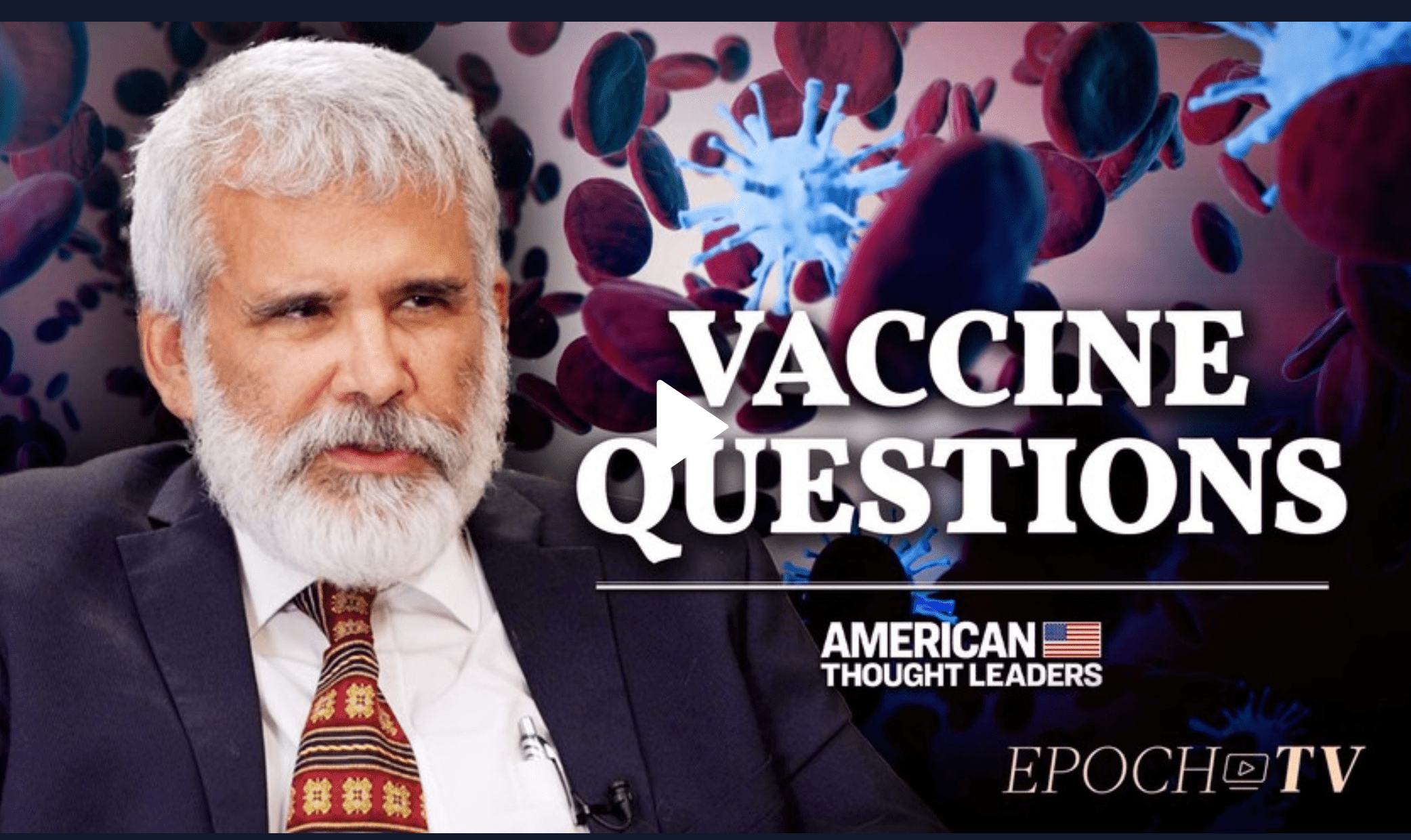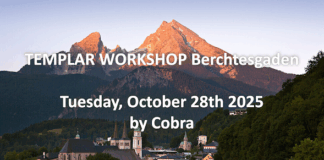From TheEpochTimes:
“We need to confront the data [and] not try to cover stuff up or hide risks,” says mRNA vaccine pioneer Dr. Robert Malone.
What does the most recent research say about the efficacy of COVID-19 vaccines? In this two-part episode, we sit down again with Dr. Malone for a comprehensive look at the vaccines, booster shots, repurposed drugs like ivermectin, and the ethics of vaccine mandates.
Jan Jekielek: Dr. Robert Malone, it’s such a pleasure to have you back on American Thought Leaders.
Dr. Robert Malone: Always my pleasure, Jan, and thank you for the chance to come back and visit.
Mr. Jekielek: I want to read you a few headlines that I’ve come across in the last few weeks since we did our recent interview, and give you a chance to speak to them. This is a drophead: “Robert Malone claims to have invented mRNA technology. Why is he trying so hard to undermine its use?” How do you react to this?
Dr. Malone: That’s the Atlantic hit piece. It was a very interesting article because it has a number of logic jumps and irregularities. Then it ends up contradicting itself in the last paragraph, and basically confirming that my assertions about having being the originator of the core technology are valid. I’m subjected to this meme that you didn’t really do the things that you did in the late 1980s almost continuously, usually from internet trolls.
So really what the young author was picking up on was some internet memes that have been wrapped around the prior press push that Katie Kariko and Drew Weissman were the ones that had originated the technology. Now that was clearly false, but it was very actively promoted by their university, which holds a key patent, and then advanced through Stat News, Boston Globe, CNN, and then finally the New York Times.
We challenged that, and in the case of the New York Times, they actually recut their interview and podcast with Katie Kariko to cut out the parts where she had claimed that she was the original inventor.
But how do I react to it, this kind of pejorative use of language to cast shade? It doesn’t really bother me. I know what the facts are, and I have this massive amount of documentation. When people come at me with those things, I just say, “Hey, look, here it’s on the website. Here are the documents, you can make your own assessment.”
The thing that bothers me about all of this, when they’re personalizing character assassination on me and character attacks, is that it distracts from the issues. And it’s not about me, this kind of chronic questioning of why would I be saying things about the ethics of what’s going on? Why would I be raising concerns about the safety signals? I must have some ulterior motive.
There’s an underlying theme to all this, that I must have some ulterior motive. This particular journalist asked me again, and again, and again, trying to get at, “What was my ulterior motive for trying to undermine these vaccines based on my technology?” It was so paradoxical, the push of a whole series of questions that he raised with me.
I don’t know what it says about journalism or what it says about our culture, that we always assume that someone must have an ulterior motive. It’s not sufficient to just be addressing an issue because it matters, because it is the ethically correct thing to do. There seems to be this assumption that everybody’s got an angle. It says more about the author than it says about me.
This kind of casting shade and aspersions on me personally as a way to avoid addressing the underlying issues, I just see it as a kind of noise and also a little bit sad. It’s almost an affirmation. If the strongest thing they can come up with is to try to attack and cast shade on whether or not I made a significant contribution that led to over nine patents during the late 1980s—if that’s the worst they can throw at me, I’m doing pretty good. So that’s how I see it.
Mr. Jekielek: So you’re not trying, “So hard to undermine the use of this vaccine technology.”
Dr. Malone: No. My concern here, as I said in our prior interview, is that there’s been a series of actions taken, policies taken, regulatory actions taken, that are at odds with how I’ve been trained with the norms as I’ve always understood them. The regulatory norms, the scientific norms—these things have been waived. For a lot of people, it doesn’t make sense.
And recall, reeling back, what triggered this was this amazing podcast with Bret Weinstein and Steve Kirsch, where I don’t think at that point in time the world had really heard anyone questioning the underlying safety data assumptions and ethics of what was being done. There was a widespread sense of unease about these mandates and efforts to force vaccinations, and expedite the licensure of this and deploy it globally on the basis of very abbreviated clinical trials. There was a widespread sense of uneasiness.
But people didn’t really have language to express it. When that podcast happened, for some reason, it catalyzed global interest in a way that I didn’t expect. I still have people writing me, “I just saw the Bret Weinstein DarkHorse Podcast.” Something happened there, where events came together. I expressed some things that I had just been observing that I felt were anomalous in how the government was managing the situation, in the nature of the vaccines, in the testing of the vaccines, and in the ethics of how they were being deployed and forced on children, plus other things in various countries, including the United States.
That triggered a whole cascade, but it wasn’t because I had concerns about the technology or was casting shade on the technology, I’ve repeatedly made it clear that, in my opinion, these vaccines have saved lives. I get challenged on that all the time, by the way. There’s a whole cohort that says, “Oh no, these aren’t worth anything. They shouldn’t be used at all. They’re not effective.”
In my opinion, they’ve saved a lot of lives and they’re very appropriate at this point in time. The risk benefit favors administration of these vaccines, even with all we’ve learned since in these last few months, it favors their administration to the elderly and the high-risk populations. So contrary to this thread of I’m trying to denigrate these and tear them down—no, I’m trying to say I’m all in favor, strongly in favor of ethical development and deployment of vaccines that are safe, pure, effective, and non-adulterated.
I’m really strongly dug in that we need to confront the data as it is, and not try to cover stuff up or hide risks or avoid confronting risks. In my opinion, the way that we get to good public policy in public health is we not only recognize those risks, but we also constantly take the position of looking forward, looking for leading indicators of risk, performing risk mitigation, and monitoring for black swans and unexpected events surrounding that.
That’s where I come from, strongly believing that the norms that have been developed over the last 30 to 40 years in vaccinology should be maintained. We shouldn’t jettison them just because we’re having a crisis.
Mr. Jekielek: Why don’t we do a review? There’s been a number of very significant papers in the last week or two that have come out with very robust data sets telling us, to my less educated eye, some very valuable information. If you agree, maybe you can review some of these for us. I know you’ve been studying every one of these in some detail.
Dr. Malone: The emergence of the Delta variant, whether originally in India and then subsequently in the UK and then in Israel, has really thrown back the public health enterprise globally and in these countries, because there were assumptions made about the effectiveness of the current vaccines and their ability to contain the outbreak. There was almost a social contract set up between the vaccine recipients and the governments and public health authorities.
That social contract was, “Despite what you may have heard about the risks of some of these products and the fact that we admittedly did rush them, we’re protecting your health. If you take these products, you will be safe.” That’s the social contract. “Despite all these other concerns, you will be safe, and you won’t have to retake them. You’ll be protected.” People believed they had a shield if they bought in and did this.
And then the Delta variant came along, and suddenly that was no longer valid. The assumption that had been made, the social contract, was somehow broken. First we found out, if you’ll recall this cascade of events—we had Pfizer disclose that the durability, the length of time that the vaccine would provide protection was not as expected. It was something like six months. This came out of the Israeli data.
Mr. Jekielek: Just to be clear, are we talking about protection from infection or protection from disease?
Dr. Malone: That’s a whole other rabbit hole. It really was protection from infection and spread that was the main parameter of concern with the six month data. You may recall that announcement was made unilaterally by Pfizer based on the Israeli data, and then immediately contradicted by Dr. Fauci saying that this wasn’t true and Pfizer had no right to make these statements, and they hadn’t discussed it with him. Pfizer then apologized and backed down.
And a week later, the U.S. government announced, that in fact, we were going to need to have boosters. Then there was the announcement that the government had contracted to buy the boosters that were going to be deployed at eight months. Then more data came out. Now most recently the government is saying, “We may have to have boosters at five months.” There was emergency use authorization that this third dose would be deployed to elderly and immunocompromised. And now we’re talking about everybody needing it.
So this was the logic, “Take the dose, take the two shots or the one-shot for J&J and you’ll be protected. We’ll get out of this because we’ll reach herd immunity. The whole problem is that we just don’t have enough people that are being compliant with this.” Remember, this goes back to July 4th.
July 4th was the goal when we were going to have 70 per cent vaccine uptake. We didn’t meet that. And there was a lot of discomfort with the Israeli data. Then all of this new information is rolled out, the Israeli data in particular, having to do with the increasing number of infections and hospitalizations.
At first the position was that this was only occurring in the unvaccinated cohort. Then that became increasingly untenable and it became clear that it was occurring in the vaccinated cohort. The same became true with the UK data set, which is stronger than the American monitoring system. They do a lot more sequence analysis.
So now we had this paradox that those that had been vaccinated, while the data still suggested that they’re largely protected from disease and death and more protected than the unvaccinated from disease and death, they’re no longer protected from infection. It became clear within the data, and through multiple sources, that the levels of virus replication in the individuals, even who had been vaccinated previously, was the same or higher as the levels of virus replication in those that had been un-vaccinated. And also that those that had been vaccinated and had breakthrough infections, which is what we’re talking about, were also shedding virus and able to spread virus.
So that raised the prospect that they were kind of the new super spreaders, because they would have less apparent disease and yet still be shedding high levels of virus. Then we started to see some signs suggesting that there may be some differences in the nature or onset or titers of disease in those that had been infected beyond six months after their vaccination point. This is the waning phase.
That set up a situation where a lot of folks were on edge. There were still a lot of media pushing that this was a pandemic of the unvaccinated, but that became increasingly untenable as the data rolled in.
You’ve referred to this paper that came out. There were actually three in a row that came out almost immediately after the license was issued for the BioNTech product.
There was a paper published in the New England Journal of Medicine that had an odd structure in which they related adverse events associated with the virus infection and a much more comprehensive assessment of adverse events associated with the vaccines. By juxtaposing these two data sets in the same manuscript, the case was made that, “Yes, we have this significantly enhanced spectrum of adverse events associated with the vaccine beyond what had been previously disclosed. We were all focused on the cardio-toxicity.”
But now, additional adverse events, and things that we discussed when we had our last chat as parent adverse events, these are now fairly well-documented in this New England Journal article, things like viral reactivation. So this is the shingles, for instance.
The paper attempts to make the case that, “The vaccines have a lot of adverse events, but the disease has a lot of adverse events also, and the disease is worse. Also there’s a lot of overlap between these adverse events associated with the disease and the vaccine.” But the messaging was focused in that manuscript that it was far worse to get the disease than to have the adverse events associated with the vaccine.
That’s a little bit of a false analogy, because the vaccine ostensibly would be deployed to 80 or 90 per cent of the population. And in terms of this wave of Delta, we might see something like 20 or 30 per cent of the population infected if we’re lucky. Then there’s an imbalance of who’s at risk with the vaccine versus who’s at risk for the infection, but that was the construct.
Mr. Jekielek: And just to be clear, what do you mean by 20 to 30 per cent, if we’re lucky? Where do those numbers come from?
Dr. Malone: I’ve seen data suggesting that the total population right now that’s been infected in the United States is something like about 20 per cent of the total population. We don’t have that widespread of an uptake of infection in the U.S. or in the UK. UK data also shows those kinds of numbers. They’re reflected in a cohort that have had a natural infection and recovered from that, and then acquired the immune response associated with that.
It’s seen in the numbers, for instance, in those cases where there is an accounting, such as in the Great Britain database, the British database, where they say the fraction of the population that’s been vaccinated, and then the fraction of the population that’s acquired natural immunity. It’s also covered in the CDC slide deck that was leaked. I don’t think that was available when we had our last conversation.
At the early outset, at the front edge of the Delta outbreak here in the United States, there was a key slide deck that was disclosed to the Washington Post without approval by a CDC employee. Within that slide deck, it showed a number of confidential internal assessments that weren’t intended to be shared with the public. Those assessments also included an estimate that we had something like 50 per cent of the population that had accepted vaccine at that point in time. In addition, there was something like 20 per cent of the population that had been infected.
So if you add those two, if you were to consider natural infection as providing some degree of protection against the virus, then we would move from something like 50 per cent vaccine uptake to something like 70 per cent of the population at that point in time that had actually acquired some form of immunity either through vaccination or infection. So that’s the basis of my seat-of-the-pants estimate.
In addition, in the CDC slide deck, the government revealed in two key slides that were at the center of that deck, that their epidemiologic calculations and projections were such that the reproductive coefficient of Delta was something in the range of eight. There’s other papers that suggest it’s more like a little over five, that it was as infectious as chickenpox approximately, which is highly infectious, about two to three times more infectious than the Alpha strain was.
Based on those projections and some assumptions about the percent of the population that had been naturally infected, and the percent of the population that had taken up vaccine, and some assumptions about the effectiveness of mask use in protecting either an individual from being infected by a third party that wasn’t using masks or protecting a third party from infection from somebody that was using a mask and was infected—there were a series of projection curves about how that could impact on the spread of the virus.
Basically when you work through those curves, what they demonstrated was that even if we had 100 per cent vaccine uptake with these vaccines, where the technical term is leaky, that do not provide perfect protection against infection, that we would not be able to stop the spread of the virus through the U.S. population. We would slow it. So that’s where those estimates come from.
That’s where that assessment that is being used as the basis for advocating widespread mask deployment throughout the United States, that’s where that policy comes from. It’s a CDC analysis that if we don’t use masks, then the virus will spread quite rapidly. If we do have full compliance with mask use, we can slow it down a bit. And so that’s why we have these various mask mandates throughout the United States now.
Mr. Jekielek: Fascinating. You started talking about natural immunity here. I thought it was some of the most interesting, robust data, at least to my eye. Again, you’re the one who’s going to be speaking on this.
Dr. Malone: I agree, and a lot of people agree. It was covered in Science magazine. It’s still a pre-print, but it was robust enough, and well enough constructed that even on the basis of the pre-print, Science magazine went ahead and made the clear point. Really, throughout the world, there was recognition that this new data coming out of Israel, as I recall, demonstrated that the term that’s often used is natural immunity. It’s an odd term, but it’s now in common language.
What that means is protection afforded by having been infected and recovered from infection, which will generate a broad immune response. And it’s now been shown in that paper and others that the breadth of that immune response in terms of memory T and B cell populations is more diverse and more long lasting than the breadth of immune response elicited by the spike based vaccines alone.
That data that you’re alluding to showed that this natural immunity is broader and more durable, which contradicted some studies that the CDC had developed. So we were in a kind of tension. Which is the real data, the CDC data, or these other papers that are evaluated memory T and B cell populations? Which is true? We have multiple truths or multiple pieces of data, plus different groups claiming it’s one way or the other.
Then this data was dropped about the evidence of protection. It seems to indicate and be consistent with the claims that the breadth and durability of the immune response was superior with the natural infection in recovery. There’s also evidence that there’s a significant, depending on the timeframe, six to twenty-fold improvement in protection from infection and disease associated with the natural immunity acquired from prior infection, compared to that conferred by the vaccine.
So now the public, in their social contract with the public health agencies, is faced with the situation where they had been told that natural immunity was not as protective, and that they can’t rely on that. If you’ve been previously infected, you should still get both doses of vaccine, and this vaccination would provide broad, durable protection. It would protect you, and it would protect your elders from you potentially spreading disease to them.
Now, those things have all come into question. The population is still reeling from that. We have kind of dug into these camps. My sense is that people haven’t really fully processed what this means. It is profound.
We were discussing before we started shooting, that I had a long podcast interview today and a kind of advisory session with a group of Latin American physicians and scientists that were evaluating public policy for vaccine rollout versus early treatment options for the different cohorts that they have to protect. They were seeing this data from the eyes of folks that really haven’t had good access to vaccines, but are facing the prospects that their countries could execute vaccine contracts and bring in these vaccines. They are asking the question, “Does this make sense for us? Is this good policy? Should our country invest in these mRNA vaccines?”
That is why they were talking to me. “What are we going to get for it if we do this? What’s going to be the benefit to our population?” It was a very level-headed discussion. But they were pushing me in this, getting back to this theme of me being the vaccine skeptic. They were the ones pushing me saying, “We just don’t see the value here for our populations. We don’t see a compelling case when these products aren’t stopping the spread. They are going to have to be re-administered fairly frequently if they’re to be effective?”
Now, the other thing that comes out of this, a concern that the World Health Organization hasn’t really come to terms with—I’m speaking of the CDC and the WHO and the whole global infrastructure, including the Israeli government—is one of now mandating a third jab. So in Israel, if you haven’t received all three, you’re not considered fully vaccinated.
Mr. Jekielek: You have a six month window, if I’m not mistaken.
Dr. Malone: Precisely. But one of the things about the Israeli data is that they vaccinated in such a bolus, in such a short push, because they have such a compliant population, that essentially, they have a spike in vaccinated persons. So they’re all moving concurrently through that six month window now.
There was a pivotal interview with the director of the CDC and she was asked, “Do we have any data? Do we have data, or do we just have hope about the benefits of the third dose?” And she, to her credit, acknowledged that we don’t have data. All we have is hope.
Here’s the problem with that. Vaccine responses are not linear. More is not better. There are many cases where if you dose more or dose more frequently or move beyond a prime and a boost, you can actually quench the immune response. You can move into “high zone tolerance.” You can move into a situation where your immune responses drop.
Now there’s a little bit of foreshadowing on this in another paper that’s out where they looked at the effects of vaccination post-infection. Remember this was the policy, that those like me that have been infected should go ahead and take two jabs, take two doses of vaccine.
Mr. Jekielek: Which you did.
Dr. Malone: Which I did, hoping that it would be helpful for a long COVID period. That data hasn’t really played out that way. And there’s a paper showing that you can actually quench T-cell responses. You get an improved kind of a super immune response, they assert in that manuscript, after a single dose when you’ve been previously infected. But with the second dose, your T-cell population actually gets quenched, which is consistent with high zone tolerance.
So if that paper was to be expanded and verified with more robust numbers, it would suggest that one dose after natural infection would be a good thing. Two doses would be a bad thing. Now that’s the equivalent of three doses if you think about it, natural infection being dose one.
So to say that we don’t have any data is a little misleading. We have some leading indicators that suggest that it might not be such a good idea. And now, that data will come out from Israel. The conservative position to take is time will tell, and then we will know.
The Israelis continue to be in the throes of a very active Delta virus infection surge right now. There’s some other very intriguing tidbits going on here in this whole public policy of vaccines versus no vaccines, versus universal vaccines, versus the Barrington position that we should selectively vaccinate those that are at high risk.
Mr. Jekielek: The Great Barrington Declaration?
Dr. Malone: Yes, the Great Barrington Declaration. After that whole matrix of decisions, in comes Sweden. You may recall that Sweden was roundly criticized for this naive notion that they weren’t going to vaccinate. They were going to allow the virus to have its will with the population. They have backtracked from that now, to be technically accurate. They have about 40 per cent vaccine uptake and they’ve acknowledged that position was naive and counterproductive. They had excess deaths initially in the high-risk cohorts.
But what they did do was have a lot more natural infection with alpha and beta strains. And now that Delta is moving through the region, they have an extremely low mortality rate, often hitting zero on any one day—in comparison to some of their neighbors that didn’t take that policy, and didn’t have such widespread natural infection. Like Finland, for example, where they deployed vaccine very avidly and had good uptake, they’re having the exponential growth rate curve that’s happening in many other Northern European countries right now.
Mr. Jekielek: I’m going to comment here. This is very interesting because you’re interpreting this data a bit differently than Dr. Martin Kulldorff, who is from Sweden. His commentary in a recent interview we did was simply that there were no mandates of any sort ever in Sweden, yet their vaccine use is actually quite high. He said it’s one of the higher rates that exist. But he didn’t factor in this time period that you said at the beginning, where there was this idea of letting the natural infections happen. And you’re saying the reason their rates are zero mortality is because of that.
Dr. Malone: Yes. It is a very reasonable explanation for what’s happened there. It’s a differentiator between them and some of their neighboring countries. They did have that early policy and they did have fairly widespread infection. So that would be consistent with the data suggesting that natural infection is providing broader and more durable immunity.
This gets to the logic of a selective deployment of vaccines to those that are at highest risk. For that fragment of the population, let’s say below 65, depending on where you want to cut the line, 60, 65, 70, some people go down to 55, not providing vaccine coverage to those individuals unless they’re in a very high risk population, morbidly obese, or with immunologic deficiencies—that may be a more enlightened public policy.
By the way, it is one more consistent with the WHO position that we still have limited vaccine supply, and it would be far more appropriate and equitable to deploy that vaccine supply more broadly globally to protect the elders in particular throughout the world, rather than this focus on universal vaccination.
Now with a booster, a third booster, a third dose, there’s been multiple statements by the WHO that they believe this is not ethical. Now, I had another interview today with a journalist podcaster who is from South Africa but living in France, and very aware of the French resistance that’s developing now to vaccines with all those protests.
Mr. Jekielek: To vaccine mandates, correct?
Dr. Malone: In particular, yes. His point was that if you look at this through the eyes of emerging economies, this Western focus on universal vaccination of their populations and now a third vaccine for their populations and their unwillingness to share the technology is a form of imperialism and hegemony. The Western nations have access to this technology and these doses and they’re not willing to share it with the rest of the world.
So we’ve got a series of things here where this kind of imbalance in distribution of these vaccines as a resource is creating or exacerbating concerns that exist widely in economically disadvantaged countries. There’s just not a level playing field and we’re all in this boat together with this disease. Yet we’re not being equitable in distribution of the countermeasures that are available.
Mr. Jekielek: This is fascinating, even as others that you’re speaking with are asking, “Do we even need these at this point?” That’s fascinating.
Dr. Malone: Yes, I agree. So what does this mean? I don’t know. What I sense is, again, we’re in one of those moments where there is chaos. There’s lack of structure and consensus about how to move forward. And my sense is, getting back to the U.S. government, we’re in a position now where a lot of the core assumptions underlying the vaccine strategy have been called into question. We don’t really know what’s on the other side.
Then on top of that, it’s becoming increasingly apparent that these repurposed drugs and other agents that could provide protection and mitigate death and disease, if they were deployed early in outpatient environments, access to those that are being actively suppressed. That’s another one of those, “This doesn’t make sense,” kind of problems. It is causing a lot of questioning about the motivations of those that are guiding public policy right now.
The second part of this episode will be released on Saturday, Sept. 4, at 7 p.m. ET.
Below is a list of references mentioned or related to the discussion in this episode:
“Vaccinated and unvaccinated individuals have similar viral loads in communities with a high prevalence of the SARS-CoV-2 delta variant” (Note: This is a preprint).
“Fauci: Amount of virus in breakthrough delta cases ‘almost identical’ to unvaccinated” — The Hill
“Predominance of antibody-resistant SARS-CoV-2 variants in vaccine breakthrough cases from the San Francisco Bay Area, California” (Note: This is a preprint)
“New delta variant studies show the pandemic is far from over” — ScienceNews
“Read: Internal CDC document on breakthrough infections” — The Washington Post
“New UCSF study: Vaccine-resistant viruses are driving ‘breakthrough’ COVID infections” — The Mercury News
“Comparing SARS-CoV-2 natural immunity to vaccine-induced immunity: reinfections versus breakthrough infections” (Note: This is a preprint)
“Having SARS-CoV-2 once confers much greater immunity than a vaccine—but vaccination remains vital” — Science
“Differential effects of the second SARS-CoV-2 mRNA vaccine dose on T cell immunity in naïve and COVID-19 recovered individuals” (Note: This is a preprint)
“SARS-CoV-2 variants of concern and variants under investigation in England” — Public Health England
“Safety of the BNT162b2 mRNA Covid-19 Vaccine in a Nationwide Setting” — The New England Journal of Medicine
“Real-World Study Captures Risk of Myocarditis With Pfizer Vax” — MedPage Today
“CDC: Covid-19 Vaccine Effectiveness Fell From 91% To 66% With Delta Variant“ — Forbes
“SARS-CoV-2 infection induces long-lived bone marrow plasma cells in humans” — Nature
CDC: “Reduced Risk of Reinfection with SARS-CoV-2 After COVID-19 Vaccination — Kentucky, May-June 2021”
“Causes and consequences of purifying selection on SARS-CoV-2” — Genome Biology and Evolution
“The reproductive number of the Delta variant of SARS-CoV-2 is far higher compared to the ancestral SARS-CoV-2 virus” — Journal of Travel Medicine
“Mutation rate of COVID-19 virus is at least 50 percent higher than previously thought” — Phys.org
“Differential effects of the second SARS-CoV-2 mRNA vaccine dose on T cell immunity in naïve and COVID-19 recovered individuals” (Note: This is a preprint)
Disclaimer: We at Prepare for Change (PFC) bring you information that is not offered by the mainstream news, and therefore may seem controversial. The opinions, views, statements, and/or information we present are not necessarily promoted, endorsed, espoused, or agreed to by Prepare for Change, its leadership Council, members, those who work with PFC, or those who read its content. However, they are hopefully provocative. Please use discernment! Use logical thinking, your own intuition and your own connection with Source, Spirit and Natural Laws to help you determine what is true and what is not. By sharing information and seeding dialogue, it is our goal to raise consciousness and awareness of higher truths to free us from enslavement of the matrix in this material realm.
 EN
EN FR
FR


























